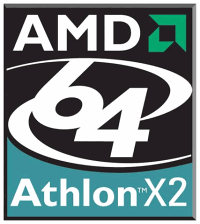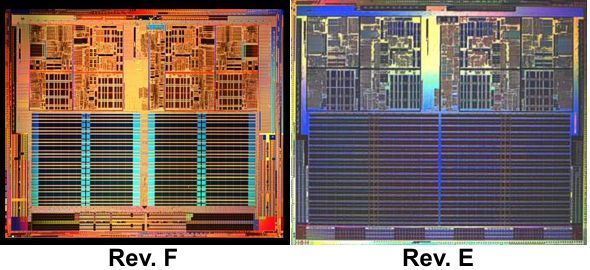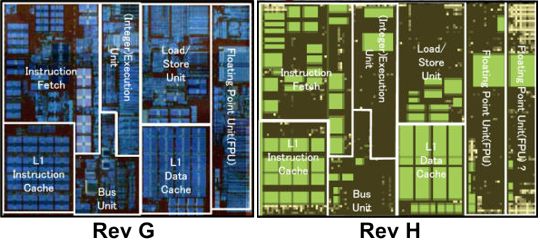Debut of AMD AM2: the long-awaited DDR2 on AMD Athlon X2

Date: 23.05.2006 |
|
Author: , Dmitry Sofronov

This day can be called a reference point of the new epoch of AMD's processor architecture. It's just today when AMD has announced a start of delivery of dual-core AMD Athlon 64 FX-62 and AMD Athlon 64 X2 5000+ processors compatible to the new AMD Socket AM2, which support the AMD Virtualization technology and non-buffered DDR2 memory. Of course, along with the top-end processors there has been announced a whole line of new chips AMD Athlon 64 X2, AMD Athlon 64 and AMD Sempron compatible to the Socket AM2.
Indeed, the long-awaited implementation of support for the DDR2 memory by AMD chips is undoubtedly an eminent event, although the processor core this time hasn't undergone any radical changes. The single- and dual-core processors for the new Socket AM2 that have been announced today offer a new controller with support for the DDR2. Along with that, for the first time there has been implemented support for a number of new technologies, with the operation of already known functions optimized, and several other architectural innovations introduced. However, in terms of evolution it doesn't reflect anything more than the new core stepping - Revision F. Consolidating the real architectural innovations announced today, we can count the following four points:
- Support for DDR2 SDRAM memory
- Support for the AMD Virtualization (AMD-V)
- Implementation of processors with economical power consumption
- Implementation of support for the 2-channel memory by Sempron family processors
The key event underlying the transition to anew version of AMD processors for desktop PCs with the new 940-pin AN2 socket is the implementation of support for the DDR2 memory. Since the memory controller is integrated into the processor, the major complication of the stage is not the emergence of new memory chips (fortunately, the DDR2 has already gained wide occurrence and even gone down in price), and even not the emergence of some special chipset versions for the new platform (although, the need for good chipsets has always been there). The major point is how well AMD has managed to implement this integrated controller with support for the DDR2,
To start with, let's sort out all the information on new chipsets available to date and then move on to running the tests.
Architecture
The new AM2 processors by AMD are 940-pin K8 chips for desktop systems with support for the 128-bit DDR2 aimed at the new Socket AM2. From this point onwards, retail shops will be receiving more and more AM2 versions of AMD chips for all the market sectors - Athlon 64, Athlon 64 X2, and Sempron. These chips are consolidated by the DDR2 version of the Revision F processor core, although each sector has its own code name.
- Windsor - dual-core Socket AM2 processors Athlon 64 FX and Athlon 64 X2 with support for dual-channel DDR2-533/667/800 and the Pacifica technology. They are produced following the 90-nm process technology with the use of SOI; they offer 2 x 1 MB L2 cache,
- Orleans - single-core Socket AM2 processors Athlon 64 with support for the dual-channel DDR2-533/667 and the Pacifica technology. They are produced following the 90-nm process technology with the use of SOI; they offer 1 MB L2 cache,
- Manila - single-core inexpensive Socket AM2 processors Sempron with support for the dual-channel DDR2-533/667 memory. Are produced following the 90-nm process technology using SOI; offer 512 K L2 cache,
Although that is some deviation from the topic, I must point out that with the mass emergence of DDR2 versions of cheap AMD Sempron chips expected already this summer the epoch of wide use of the DDR1 memory can be regarded as quickly coming to a demise. In this regard, the quickness is of course a relative thing, and there are no plans yet to close down production of Socket 939 processors, but anyway that should be a distinct sign for reasonable buyers...
The new revision F with the former 90-nm process technology, support for the fast memory up to DDR2-800, declared Pacifica technology, economical power saving have called foe some internal re-design. On the photo below, where dual-core chips of revisions E and F are compared, the easiest to see is the increased pad between L2 caches.
 Windsor VS Toledo
Windsor VS Toledo
Actually, the drawing reproduces the scale in merely a schematic view. In fact, the area of the new core of Rev. F has been increased relative to version Rev. E by approximately 13% - up to 220 sq.mm (from 194 sq. mm). Therefore, the size of 1 MB L2 caches has been increased accordingly by 18%, so has the size of 1 MB L2 caches – from 106 sq. mm in Rev. E (in the first steppings - 115 sq. mm) to 126 sq. mm in processors of Rev. F. At the same time time, the areas of positioning SRAM L2 cache memory has gone down. While the 1 MB L2 cache size in Rev. E takes 41.4 sq. mm (therefore, 82.8 sq.mm for the dual-core structure), this indicator in new processors of Rev. F has gone down to 38.7 sq. mm (77.4 mm in the dual-core version).
The number of transistors that constitutes each chip has gone up. While in today's dual-core K8 processors there are 233 mln transistors, then in chips of Rev. F there are 243 mln, that is, by approximately 4% greater. There is a complete analogy with single-core processors: 120 mln transistors in the single-core K8 chip have been replaced with 129 mln transistors in the processor of Rev. F, where the increase is even greater - i.e.by 7.5%.
Increase in the core area with the reduction of cache area and the same process technology for the manufacture of processors of Rev. F suggest some reasoning. Indeed, AMD K8 chips of steppings Rev. D and Rev. E have been produced following the same 90-nm process technology PD-SOI (Partially Depleted Silicon-on-Insulator), with a 9-layer copper metallization.
Therefore, the area of SRAM cells in the cache has gone down, the number of transistors has gone up, so has the total area of the chip. Of course, all can be attributed to the new DDR2 memory controller (indeed, support for DDR2-800 in exchange of DDR-400 called for substantial remake of signal lines) and support for the Pacifica technology, but it seems to me something will be "ticking" in these processors for the time being. For instance, integrated but not yet declared support for the Presidio technology (an analog to Intel's LaGrande). For now it is still unknown what to do with the virtualization – AMD Pacifica, like the 64-bit computing implemented in the architecture, may also wait until the emergence of the new generation of Microsoft Vista operating systems.
Indeed, judging by the latest publications online, a substantial redesign of the core (the core, not the memory controller) is expected with the release of further steppings - Revision G and Revision H. In the case of Rev. G, at least a substantial redesign of the branch processing module is expected, and in Rev. H - even a new generation of the FPU (Floating Point Unit).
 Schematic sketch of potential cores of Rev. G and Rev. H
Schematic sketch of potential cores of Rev. G and Rev. H
In this article, it doesn't make any sense to dwell on the details of the next generation of AMD64 architectures; anyway, I would note the newly born revision of the core hasn't undergone any substantial redesign which directly affects the performance. In other words, the performance boost, albeit expected, is possible only through the rise in clock speeds and implementation efficiency of the new memory controller.
However, there is one more substantial change implemented in new AM2 processors of revision F, because chip versions with varying power consumption have been declared. Now, AMD will produce economical processors for desktop PCs of the Energy Efficient Desktop Processor class. This category includes a number of new Socket AM2 chips AMD Athlon 64 X2, AMD Athlon 64 and AMD Sempron with support for AMD Cool‘n’Quiet and improved power consumption. The new economical chips will be grouped into two subclasses - one with TDP 65 W and one with TDP 35 W.
Just imagine that now you can come across three versions of the chip with a very similar name in the retail shop - AMD Athlon 64 3500+ or 3800+ , one of them being "regular", with TDP 89 W, the other one - Energy Efficient, with TDP 65 W and finally the third version - Energy Efficient Small Form Factor Desktop Processor AMD Athlon 64 X2, with TDP 35 W. Processors AMD Athlon 64 3500+ and 3800+ will be represented in versions for Socket 939 and Socket AM2, the same is for the case with AMD Sempron 64 3000+, 3200+, 3400+, 3500+, and 3600+ processors.
 |
Content: |
 |
|
 |
Top Stories: |
 |
 |
 |
MoBo:


|
 |
 |
 |
VGA Card:


|
 |
 |
 |
CPU & Memory:

|
|
|
